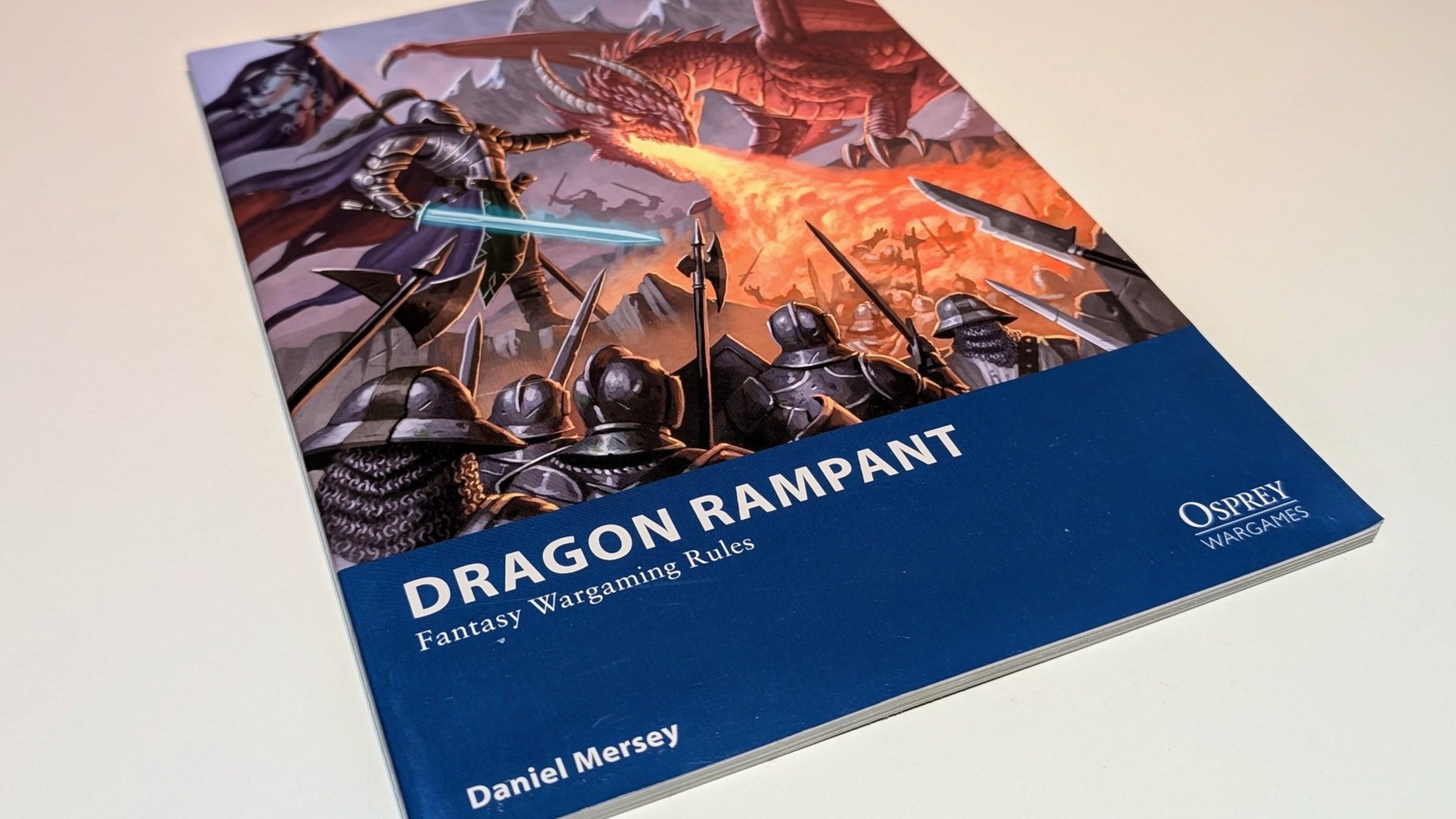Dragon Rampant Review – A Fantasy Sandbox for Hobby Veterans
It thrives as a low-prep, high-fun skirmish game that lets you use the models you love in the stories you want to tell.
When I first picked up Dragon Rampant, it wasn’t part of some grand plan to revisit the Osprey skirmish game line. I’d been aware of it for years — I remember the buzz when Lion Rampant came out, followed shortly by its fantasy cousin. Back then, I was managing the miniatures section at The Sentry Box in Calgary, and like a lot of folks, I was looking for something to fill the void left by Warhammer Fantasy Battles.
Dragon Rampant looked promising. It wasn’t rank-and-flank in the traditional sense, but its miniatures-agnostic design and open-ended list building gave it an appeal. I flicked through it, took note — and then forgot about it.
Fast-forward to 2025, and the planned move to Wigan. While researching places I might be able to play once I arrived, I came across a local club — and lo and behold, they were already playing Dragon Rampant. That was enough. I bought the rulebook before leaving Canada, packed a few fantasy armies in my shipping crates, and figured I’d make the effort to learn what they were playing rather than assuming they’d pick up what I was already into.
First Impressions & Gameplay Feel
Having read through the rules a few times before playing, I knew what I was in for: a streamlined system in the familiar Osprey "blue book" format — clean layout, straightforward writing, and lots of charming model photos that felt achievable to paint.
Mechanically, it’s very lean. You activate a unit, declare an action, roll to see if it happens. If you fail, your turn ends. That’s it. And despite the simplicity, it immediately creates tension and swingy momentum that makes games dynamic and unpredictable — in the best way.
Cleanly laid out profiles define the game’s core units — from elite foot to warbeasts.
In play, Dragon Rampant feels casual but not shallow. The 24-point format I’ve been using generally gives each player 5–8 units, and games clock in around 60–90 minutes. That’s enough time for an arc — a beginning, middle, and end — without dragging. The turn-ending-on-failure mechanic keeps things snappy, and because defending units strike back in melee, you stay engaged in the action even when you’re not the active player.
It has a strategic rhythm reminiscent of Blood Bowl, where you sequence your safest to riskiest activations. There’s no pretending this is a tightly balanced competitive system — and honestly, it shouldn’t be. This is a beer-and-pretzels fantasy skirmish game that wears its chaos proudly.
Open Design, Meta Gravity, and the Balance Question
List building in Dragon Rampant is deceptively simple. You choose from a small menu of core unit types — Light Infantry, Elite Cavalry, War Beasts, and so on — and then bolt on fantasy traits like Flying, Undead, Fearful, or Spellcasting. It’s one of the most open-ended wargame systems I’ve played.
But that freedom comes with some gravitational pull. Certain combinations — like Wild Charge, which gives a free activation attempt, or Fearful, which reduces point cost with a mild drawback — stand out as clearly efficient. There’s nothing broken here, but once you grasp the underlying math, you’ll start to see similar formations emerge unless your group intentionally builds around theme or narrative.
Leadership Traits, in particular, are a curious case. On paper, they let players create centerpiece heroes or iconic leaders. In practice, the random roll mechanic feels out of step with the rest of the game. Some results are strong, others are actively detrimental, and because players don’t choose their trait, it can feel arbitrary. Watching your berserker general roll Cowardly and be unable to attack all game, while your opponent gets Sky Darkener and hands out auto-successes, doesn’t feel particularly fun — even in a casual game.
This isn't a system that collapses under these quirks. It's one that expects you to use a light touch — agree on house rules, set narrative expectations, and treat balance as a collaborative act. But in a system that’s so beautifully permissive elsewhere, moments like mandatory Leadership Trait rolls can feel like a missed opportunity.
That said, the highs are absolutely worth it. You can run a greater daemon model as a single-model unit of Heavy Infantry, field plastic dollar-store dinosaurs as Beasts, or repurpose your old Warhammer or D&D collection without issue. Once the dice are rolling, the abstraction falls away and you’re just playing — and that’s the magic of the design.
Miniatures-agnostic by nature, the game welcomes the weird and wonderful — like this Nurgle force.
Theme, Flavor, and Fantasy Immersion
While much of Dragon Rampant’s flavor flows directly from its open unit design and mechanical structure — as covered above — it’s worth calling out how well those tools evoke a sense of classic, kitchen-table fantasy. This isn’t a game about deep lore or named characters. It’s a flexible framework that rewards imagination. And once you start using it, the flavor emerges from how you choose to play.
The book includes recommended trait combos for common archetypes like elf scouts or undead hordes, and the unit design is abstract enough that just about any model fits somewhere.
Movement is loose and cinematic, more like Middle-earth Strategy Battle Game than tight rank-and-flank. You can base your models however you want and still get tactical gameplay. Positioning matters, but it never bogs things down.
Once you’re a few turns in, the rules melt away and you’re left with cinematic moments and pulpy fantasy vibes — and that's what keeps you coming back.
The rules fade into the background once cinematic fantasy action kicks off. - Image curtesy of Wigan Tabletop Games Club
Accessibility & Barriers
The core rules are simple and intuitive. Most players will have them memorized after two or three games. It’s easy to teach, quick to set up, and forgiving to learn.
That said, the very thing that makes it accessible — its open, miniatures-agnostic nature — can also feel like a barrier to newer players. Without predefined factions or starter sets, some may feel lost on where to begin. Games like Age of Sigmar offer clear entry points with lore-rich boxes; Dragon Rampant simply hands you the keys and says, "Drive."
Mission variety is also limited in the core rulebook. There’s a lightweight quest system and some scenario options, but most groups will benefit from borrowing scenarios from Lion Rampant 2nd Edition or writing their own.
That said, the system is ripe for campaigns. You could easily port in a “Glory Points” progression system or write custom quests. I’ve written dozens of these over the years — and I wouldn’t be surprised if a Dragon Rampant campaign guide made its way to the site sometime soon.
Presentation & Community Tools
A visual tease of the production uplift we might see in Dragon Rampant’s next edition — or just a reminder that Lion Rampant 2E is worth borrowing from for scenarios.
The rulebook itself is standard Osprey fare: softcover, cleanly presented, and very affordable. It’s part of what made the “blue book” series so accessible for niche skirmish games. A Dragon Rampant 2nd Edition is due later this year, following the Lion Rampant 2E model — which means a hardcover upgrade, a polish pass on the rules, and likely a bump in cost.
Community-wise, the game has a modest but passionate following. There are Facebook groups, a few list-building tools, and hobby blogs — but most of the time, pen and paper will do. The system’s simplicity means you’re rarely more than one game away from remembering everything by heart.
About Our Review Scores
To keep things consistent across future reviews, we use a simple five-category system to rate each game or product. Each category is scored out of 5, with short commentary to explain the reasoning. While the overall score gives a rough benchmark, the breakdown is where you’ll find the real insight.
Here’s what each category means:
Core Mechanics Clarity of rules, tactical depth, and gameplay flow. High scores reward smooth, engaging systems.
Theme & Flavor How well the game evokes its intended setting or tone — through mechanics, not just art or lore.
Accessibility How easy it is to learn and start playing — factoring in rules, price, and onboarding support.
Replayability Does the game evolve over time? Are there enough missions, army options, or tools for longevity?
Production & Support Rulebook layout, artwork, component quality, and ongoing community or publisher engagement.
| Category | Score | Comments |
|---|---|---|
| Core Mechanics | 4/5 | Streamlined and engaging, with quick turns and swingy outcomes that keep things exciting. Some rules quirks and lack of tight balance may frustrate tournament-minded players. |
| Theme & Flavor | 4/5 | Offers a rich fantasy feel through tone and flexibility rather than lore. Abstracted factions and open unit design make it easy to tailor to any setting or collection. |
| Accessibility | 4.5/5 | Rules are simple and quick to grasp, and the miniatures-agnostic nature lowers the barrier to entry. However, the open-ended army design can lead to decision paralysis for total newcomers. |
| Replayability | 3.5/5 | A flexible sandbox, but limited by sparse scenario support. Expansions or player-made content are essential to keep things fresh. Second Edition is likely to improve this. |
| Production & Support | 3/5 | Osprey’s standard softcover format is no-frills but effective. Online support fills the gaps, and the upcoming hardcover Second Edition should elevate things even further. |
Total: 19/25
Final Verdict: Embrace the Chaos
Elite Aztec Foot move through the Welsh Village, avoiding the Chariot Unit — a perfect demonstration of how Dragon Rampant encourages double-dipping with whatever you already own. Image courtesy of Wigan Tabletop Games Club.
Dragon Rampant is a gift to hobby veterans: a flexible, fast-playing system that rewards creativity over optimization. It doesn’t pretend to be a tournament-ready engine — and trying to force it into that box would only waste its potential.
Instead, it thrives as a low-prep, high-fun skirmish game that lets you use the models you love in the stories you want to tell. Whether you’re blowing the dust off old armies or converting dinosaurs into war beasts, Dragon Rampant invites you to enjoy fantasy wargaming on your own terms — and maybe even share it with a few friends who haven’t rolled dice in a while.






